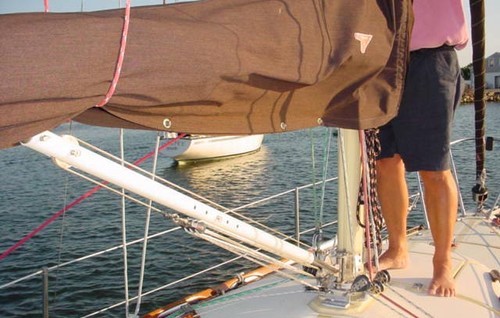Nine Reasons to have a Fixed Boom Vang
by Ian Broad/Sail-World on 2 Feb 2008

So many reasons to have one SW
Ian Broad is well known to many Australian sailors as the principal of Hood sails. His knowledge and expertise in the area of sail making and sailing techniques with those sails is recognised as first class.
Here he tells the story that inspired him to create the nine reasons why you should install a solid boom vang on your sailing boat:
'I had a call from an owner who wanted a new main for his 38 foot centre cockpit sloop. This was hardly an unusual request, so I went to measure his boat for the new main without any premonition of problems.
‘When I arrived at the boat, I was amazed to find it seriously damaged. The guardrails and the steering pedestal were destroyed.
‘The owner ruefully recounted the story. He was outside Sydney Heads, alone in the boat, when the steering broke just as a ‘southerly buster’ arrived.
The ‘Southerly Buster’ is a sudden climatic event, quite common on the New South Wales coast, which arrives sometimes out of blue skies. Occasionally the winds are of alarming force, often accompanied by rain and thunderstorms, and all those who sail along that coast are particularly wary of a suddenly southerly, even though they are usually over in a couple of hours.
So it’s not surprising that the owner of the boat, single-handed and ‘caught out’, was in some hurry to get the boat under control. He fired off the main halyard to bring the main down. The main boom crashed into the pedestal and went straight over the side, as in his haste he hadn’t had time to attach the topping lift. Both the pedestal and the guardrails were seriously damaged as the end of the boom bounced over the side into the water.
How he returned to base with no main and no steering is yet another story - a small nightmare that we all dread.
‘I suggest that you don’t get a new main immediately’ I said. ‘I think you should consider an adjustable vang with a gas strut to hold the boom up without a topping lift.’ I proceeded to enumerate the advantages of this change.
‘Alarmed by his experience, he took my advice. With the new vang in place I then arranged a sail to suit and I asked him some weeks later how he found the new arrangement.
‘Here are the advantages that we both agreed on, which I would suggest all skippers consider when the opportunity for change arises:
1. It is much easier to hoist and drop the sail, one step being removed from the process.
2. The skipper doesn’t have to worry whether a crew member is going to drop the topper instead of the main halyard.
3. Reefing is easier, as the boom goes up to meet the leech reef point.
4. There is less chafe on the leech.
5. Peace of mind that the boom will stay up if the halyard breaks.
6. But best of all, shape is maintained in light weather, as the weight of the boom does not drag the leech down.
7. For short handed sailing, greater control of every aspect of main handling results, especially when reefing with in-mast, in-boom systems or a traditional slab. This applies whether or not the sail is fitted with lazy jacks.
8. When reefing single handed, time at the mast is considerably reduced.
9. As there is no topping lift, the spare masthead sheave can be used for a spare main halyard, or a light mouse line for future halyard installation.
‘His sailing is now safer, and much more fun as a result.
‘Apart from the peace of mind and greater freedom of sailing, a solid vang, which is more expensive than the old fashioned block and tackle style, will actually pay for itself over time. This is because the need to repair the main due to chafing from the topper has been eliminated and reefing damage is also kept to a minimum.'
Aside from his professional qualifications and eye for a good sail plan, Ian Broad has a wealth of experience in general sailing. He started sailing at an early age and owned his first 18ft skiff at 16 and progressed through to yachts after starting as an apprentice sailmaker in 1969.
He became involved with the America’s Cup in 1970 with Gretel 2 helping Peter Cole and subsequent challengers working with such talented people as the late Ben Lexcen. An extensive offshore racing calendar followed including 17 Hobarts Fastnet Clipper cup and a Japan Cup, sandwiched between the usual costal races. However, he says he has always been interested in the technical aspects of sail design - he still has his original set of numbers recorded from sails cut on the floor.
For complete contact information for Hood Sails Worldwide, click HERE
To contact Ian Broad’s Hood Sails in Sydney, click HERE
www.sail-world.com/send_message.cfm!Click_HERE!same to comment on this article
If you want to link to this article then please use this URL: www.sail-world.com/21818